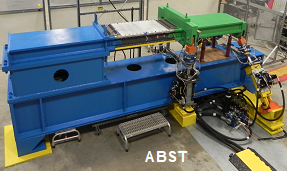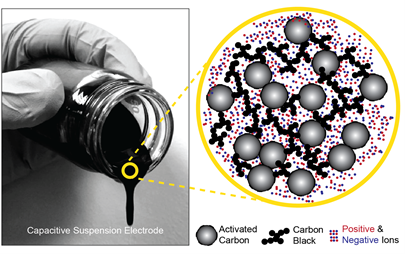2020-2021 has been an active time for MEM, with research grant awards covering a wide range of applications. From addressing gaps in our understanding of amphibian motion to developing technologies for more efficient energy storage, MEM faculty are investigating, innovating, and collaborating to expand the boundaries of possibility. Below is a list of selected grants received by MEM faculty since the pandemic began.
Bio-Alloys
 Proposed system for thixotropic shearing-mixing and 3D printing of Zn-Mg alloy. The micro-slurry obtained by melting and high-stress shearing-mixing is directly fed to an extruder for 3D printing.
Proposed system for thixotropic shearing-mixing and 3D printing of Zn-Mg alloy. The micro-slurry obtained by melting and high-stress shearing-mixing is directly fed to an extruder for 3D printing.
Professor Jack Zhou, in collaboration with Professor Donggang Yao, Co-PI, of Georgia Tech and industrial partner William G. Wilson, Jr. of Molded Magnesium Products, LLC, has received funding from the National Science Foundation for “GOALI/Collaborative Research: Thixotropic Metal Processing and 3D Printing of Zinc-Magnesium Bio-Alloys for Biomedical Implant Applications.” This award supports fundamental research to explore a novel manufacturing system that is capable of 3D printing zinc-magnesium bio-alloys and other bio-alloys highly desirable in implanted medical devices for their biodegradability and high strength. The total three-year funding for two universities is $640K.
Aviation
 The FAA’s Full-Scale Aircraft Structural Test Evaluation and Research (FASTER) facility and Aircraft Beam Structural Test (ABST) fixture at the William J. Hughes Technical Center.
The FAA’s Full-Scale Aircraft Structural Test Evaluation and Research (FASTER) facility and Aircraft Beam Structural Test (ABST) fixture at the William J. Hughes Technical Center.
Professors Tein-Min Tan and Jonathan Awerbuch have been awarded a $350,000 grant from the FAA William J. Hughes Technical Center. The two-year program will focus on studying (1) the damage tolerance and structural integrity of aircraft fuselage structures made of emerging material technologies and (2) the durability of adhesively bonded composite patch repairs of primary beam structures representative of typical aircraft wing or stabilizer components. The FAA’s Full-Scale Aircraft Structural Test Evaluation and Research (FASTER) facility and Aircraft Beam Structural Test (ABST) fixture will be the primary mechanisms to leverage resources with other stakeholders, including NASA, DoD, and industry partners such as Arconic, Boeing and Bombardier.
Biomimetic Robotics

Clio, a bio- robotic sea lion developed in the Laboratory for Biological Systems Analysis. The system uses reinforcement learning to develop policies for highly maneuverable swimming.
Professors James Tangorra and Harry Kwatny in collaboration with Associate Professor Megan Leftwich at George Washington University and Professor Frank Fish at West Chester University have received a 3-year, $1.5 million grant from the Office of Naval Research entitled “Locomotion and transitions of an amphibious system: Biologic to Robotic.” This project has two main objectives: (1) to refine our knowledge of the novel propulsion mechanisms of the California sea lion (Zalophus californianus) and extend it to high demand underwater environments; and (2) to develop a biological, i.e. morphologic and kinematic, understanding of sea lion locomotion on land. The proposed work will build on, and extend, fundamental studies of the California sea lion’s swimming mechanism and thrust production capabilities. This marine mammal displays morphological and behavioral characteristics—speed, agility, and flexibility—that allow it to operate in flow conditions that conform to projected naval operations. Additionally, it will extend preliminary work on the sea lion’s ability to operate on land. Sea lions are naturally amphibious, spending significant time in the water and on land throughout their life cycles and there are unique bio-morphological adaptations that allow them to successfully exploit both environments.
Desalinization and Clean Energy
 Capacitive suspension electrode and its constituents
Capacitive suspension electrode and its constituents
Associate Professor Caglan Kumbur was awarded a 2-year, $384,000 grant from the National Science Foundation entitled “Exploring Particle Dispersion and Charge Percolation in Suspension Electrodes: Bridging Electrochemical Performance and Rheology.” This project deals with exploring energy storage in flowing suspension fluids. Studies will be conducted to understand the role of the flow properties of flowable electrodes on their capacity for electrical energy storage. This new flowable energy storage concept will also be implemented in water desalination applications for water purification. The resulting discoveries and new knowledge gained from these studies will benefit research on emerging energy storage and water treatment technologies and help develop new scalable technologies that utilize this new class of flowable electrodes. This project will also offer significant opportunities to extend and amplify the impact of this research to society at large.
Advancing Functional Materials
 Tunable UV laser for spectroscopy
Tunable UV laser for spectroscopy
Professor Jonathan Spanier, PI in the Mesoscale Materials Laboratory, in collaboration with investigators from the University of California at Berkeley and Bar-Ilan University, received a grant entitled "High-Tunability, Low-Loss Multiferroic Materials Based on Domain Wall Resonance" to explore and develop the fundamental understanding of domain-wall oscillation and resonance effects in thin-film solid-solution multiferroic materials. Leveraging advanced materials synthesis, multi-scale modeling and simulation and cutting-edge characterization, the three-year project supported by the US Army Research Office will address limitations in the design and realization of highly tunable and low-loss dielectrics which are key for a variety of communications technologies.
Water Purification
 The world's most powerful cold underwater plasma sustained by 3 kW Tornado Stabilized Gliding Arc Discharge.
The world's most powerful cold underwater plasma sustained by 3 kW Tornado Stabilized Gliding Arc Discharge.
Professor Alexander Fridman in conjunction with Associate Professor Christopher Sales and Research Professor Alexander Rabinovich have been awarded a grant from the Department of Defense Strategic Environmental Research and Development Program entitled "Application of Non-Thermal Plasma to Water Cleaning from Contaminants of Emerging Concern." This large-scale interdisciplinary research project is focused on understanding the interaction of plasma with liquids, plasma behavior inside water bubbles, novel phenomenon of plasma mist, and applications of these systems to abatement in water of the emerging contaminants. Especial focus of the project is the destruction in water of PFC compounds (the so-called "forever-chemicals"), which are present in water on the level of ppb (part-per-billion), very dangerous for people, and extremely challenging to destroy with the majority of existing technologies.